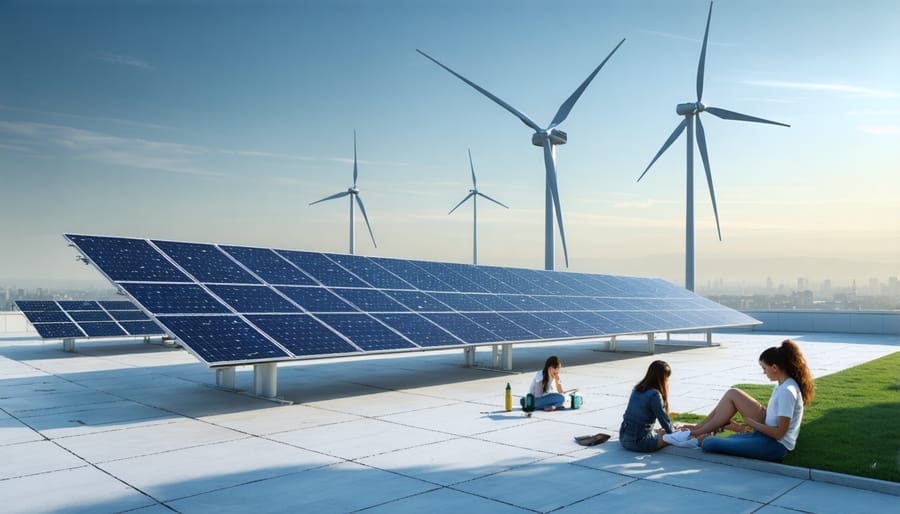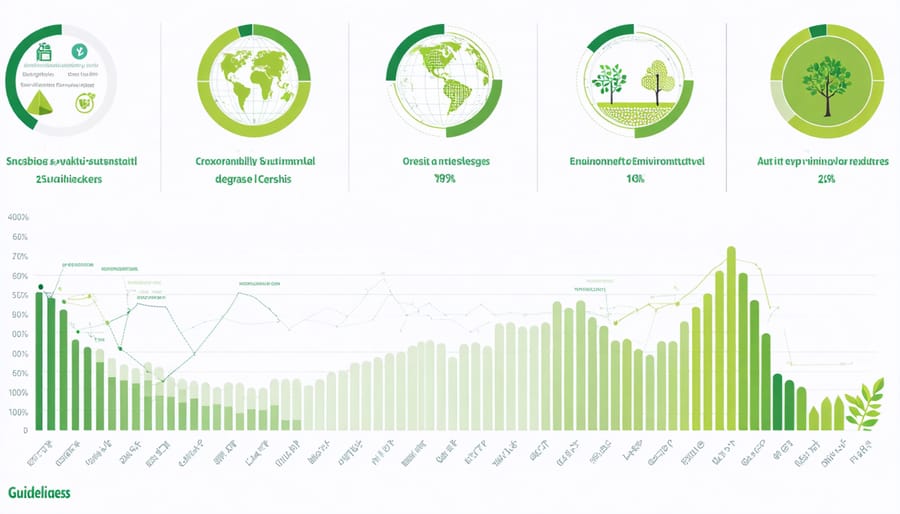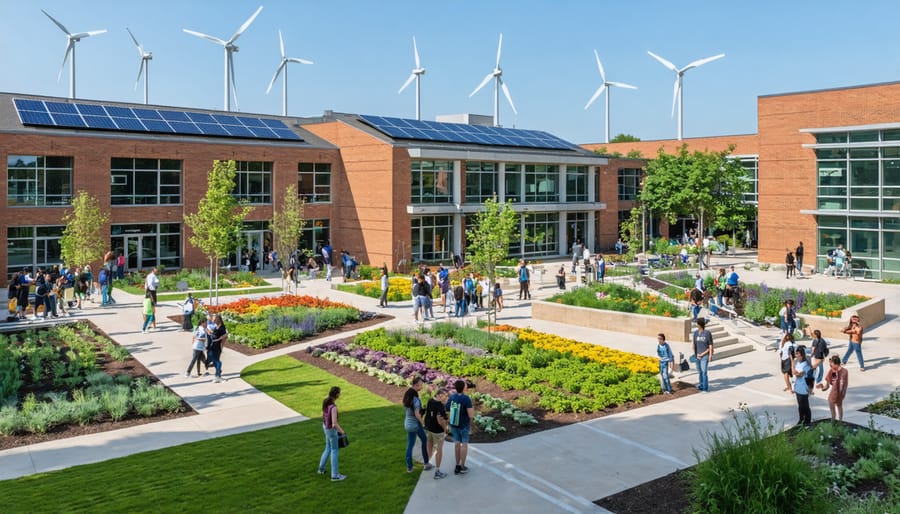Universities stand at the forefront of Australia’s sustainability revolution, transforming their campuses into living laboratories for environmental innovation. From Melbourne to Brisbane, institutions are implementing bold initiatives that slash carbon emissions, revolutionise waste management, and inspire the next generation of environmental leaders. These pioneering programs not only reduce operational costs but also prepare students for the green economy’s unprecedented opportunities.
The impact is already measurable: Australian universities have collectively reduced their carbon footprint by 30% since 2015, while creating thousands of green jobs and generating millions in energy savings. Leading institutions like the University of Queensland now power their campuses entirely with renewable energy, demonstrating that ambitious sustainability goals are both achievable and economically sound.
What sets successful university sustainability programs apart is their holistic approach – integrating green initiatives into curriculum, research, operations, and community engagement. By treating their campuses as sustainability incubators, universities are developing scalable solutions for climate challenges while equipping students with practical skills for a carbon-constrained future. These initiatives serve as powerful models for other institutions and communities, proving that meaningful environmental action can drive both ecological and economic benefits.
Building a Green Campus Culture Through Educator Training

Beyond the Classroom: Creating Campus-Wide Impact
Trained sustainability educators serve as powerful catalysts for transformative change, extending their influence far beyond classroom walls through campus-wide sustainability initiatives. These champions actively collaborate with facility managers to optimize energy usage, partner with food services to reduce waste, and guide procurement teams toward eco-friendly suppliers.
Their impact ripples through campus culture, inspiring student-led environmental groups and fostering partnerships between academic departments and operations staff. For instance, at several Australian universities, educator-led programs have resulted in the installation of solar panels, creation of community gardens, and implementation of comprehensive recycling systems.
These educators also facilitate knowledge transfer between different university sectors, ensuring sustainability principles are woven into daily operations. Through workshops, consultation sessions, and hands-on projects, they help transform theoretical knowledge into practical solutions. Their efforts have led to measurable outcomes, including reduced carbon footprints, decreased operational costs, and enhanced community engagement in environmental stewardship.
Connecting Theory to Practice
Australian universities are leading the way in bridging the gap between theoretical sustainability concepts and real-world applications. At the University of Queensland, engineering students work directly with local businesses to develop energy-efficient solutions, while environmental science students conduct field research in renewable energy implementation. These hands-on experiences transform classroom learning into practical skills.
The University of Melbourne’s cross-disciplinary approach combines business students’ expertise in creating sustainable business models with architecture students’ innovative designs for eco-friendly buildings. This collaboration has resulted in several successful campus initiatives, including solar-powered study spaces and waste reduction programs.
In Western Australia, Curtin University’s sustainability workshop program brings together students from different faculties to solve real environmental challenges. Business students develop marketing strategies for renewable energy adoption, while science students provide technical expertise on implementation. This practical approach has led to successful community projects and increased graduate employability in the sustainability sector.
These initiatives demonstrate how universities can serve as living laboratories, where theoretical knowledge transforms into actionable solutions for a sustainable future.
Essential Workshop Components
Bioenergy and Renewable Solutions
Universities across Australia are leading the charge in bioenergy research and implementation, creating living laboratories for sustainable energy solutions. At the forefront of this movement, institutions are incorporating biomass processing facilities and waste-to-energy systems directly into their campus operations, providing students with hands-on learning experiences while reducing their carbon footprint.
The University of Queensland’s innovative biogas facility, for instance, converts campus food waste into clean energy, powering several buildings while serving as a practical teaching tool for environmental science students. Similarly, Monash University’s micro-grid system demonstrates how different renewable energy sources can work together, with bioenergy playing a crucial role in the energy mix.
These initiatives extend beyond simple power generation. Universities are developing comprehensive educational programs that help students understand the full lifecycle of bioenergy production, from feedstock selection to end-use applications. Workshop programs enable students to participate in real-world projects, such as designing small-scale biodigesters or creating energy from agricultural waste.
Many institutions have also established partnerships with local farms and businesses, creating circular economy models that benefit both the university and surrounding communities. These collaborations provide valuable research opportunities while demonstrating the practical viability of bioenergy solutions in various contexts.
Through these programs, universities are not just teaching about sustainable energy – they’re actively shaping the future of Australia’s renewable energy landscape, preparing the next generation of environmental leaders with practical skills and knowledge.

Resource Management and Waste Reduction
Universities across Australia are leading the charge in resource management and waste reduction through innovative campus-wide initiatives. Many institutions have adopted comprehensive waste sorting systems, with clearly marked bins for recyclables, organic waste, and landfill items. These systems are complemented by educational campaigns that help students and staff understand proper waste disposal practices.
Smart building technologies play a crucial role in resource efficiency. Motion sensors for lighting, automated climate control systems, and water-saving fixtures have become standard features in modern campus buildings. The University of Melbourne, for instance, has reduced its water consumption by 50% through the installation of water-efficient fixtures and grey water recycling systems.
Paper waste reduction strategies have proven particularly successful, with many universities implementing paperless policies for administrative processes and encouraging digital submissions for assignments. Some institutions have gone further by creating dedicated waste reduction teams that conduct regular audits and implement improvement strategies.
Food waste management has also seen significant innovation. Campus cafeterias are partnering with local composting facilities and food rescue organisations to ensure excess food doesn’t go to waste. Several universities have established on-site composting systems that turn food scraps into nutrient-rich soil for campus gardens.
These initiatives not only reduce operational costs but also serve as living laboratories where students can learn about sustainable resource management through real-world applications.
Student Engagement Techniques
Student engagement is crucial for the success of university sustainability initiatives, and implementing effective teaching strategies can make a significant difference. One powerful approach is the creation of student-led sustainability committees, empowering learners to take ownership of campus environmental projects. These committees can organize waste audits, energy-saving competitions between residential colleges, and green awareness campaigns.
Hands-on learning opportunities, such as campus garden projects and renewable energy workshops, help students develop practical skills while contributing to university sustainability goals. Many Australian universities have successfully implemented “Green Ambassador” programs, where students become sustainability champions within their peer groups and faculties.
Digital engagement through social media challenges and mobile apps has proven particularly effective in encouraging student participation. For example, sustainability-focused scavenger hunts using QR codes around campus combine technology with environmental education, making learning both interactive and fun.
Service-learning projects that connect students with local community sustainability initiatives provide real-world experience while fostering a sense of environmental responsibility. Regular sustainability forums and workshops, where students can share ideas and collaborate on green projects, help maintain momentum and create lasting impact on campus culture.
Measuring Success and Impact
Key Performance Indicators
Measuring the success of university sustainability initiatives requires a comprehensive set of Key Performance Indicators (KPIs) that track both immediate workshop outcomes and long-term campus sustainability progress. Leading Australian universities have adopted a multi-tiered approach to assessment, focusing on quantifiable metrics that demonstrate real impact.
Workshop effectiveness is typically measured through participant engagement rates, post-workshop surveys, and the number of sustainability projects initiated by students and staff. Universities track attendance figures, with successful programs maintaining at least 80% participation rates across scheduled sessions. Knowledge retention is assessed through follow-up questionnaires at three and six-month intervals.
For broader campus sustainability progress, institutions monitor several critical metrics: annual energy consumption reduction (targeting 5-10% decrease year-over-year), waste diversion rates (aiming for 70% or higher), and water conservation (targeting 15% reduction in usage). Carbon footprint tracking has become increasingly important, with many universities setting ambitious goals to achieve carbon neutrality by 2030.
Student-led initiatives resulting from workshops are particularly valuable indicators, measured by the number of new sustainability projects launched and their subsequent impact. Success stories include campus-wide recycling programs, renewable energy installations, and water-saving initiatives that demonstrate measurable results.
Regular reporting and transparency are essential, with most universities publishing annual sustainability scorecards that showcase progress against these KPIs, fostering accountability and continuous improvement in their sustainability journey.

Long-term Implementation Strategies
To ensure the success of long-term sustainability implementation, universities must establish robust frameworks that endure beyond initial enthusiasm. Creating dedicated sustainability offices with permanent staff positions demonstrates institutional commitment and provides continuity in program management. These offices should develop five-to-ten-year strategic plans that align with broader university goals while maintaining flexibility for emerging opportunities.
Regular review cycles are essential for adapting initiatives to changing circumstances. Universities should establish quarterly assessment meetings involving stakeholders from various departments to evaluate progress and address challenges. Building strong partnerships with local communities and businesses creates support networks that help sustain programs through challenging periods.
Financial sustainability is equally crucial. Universities can establish green revolving funds, where savings from efficiency projects are reinvested into future sustainability initiatives. Integrating sustainability metrics into institutional KPIs ensures continued administrative support and resources.
Student engagement remains vital for long-term success. Creating formal roles for student sustainability ambassadors and incorporating sustainability into curriculum development helps embed these practices into university culture. Establishing mentorship programs between graduating and incoming student leaders ensures knowledge transfer and maintains momentum across academic years.
Documentation of successes and lessons learned creates valuable institutional memory, while regular communication of achievements helps maintain community buy-in and enthusiasm for ongoing initiatives.
Real Success Stories from Australian Universities
The University of Melbourne’s Green Campus Initiative stands as a shining example of what’s possible when institutions commit to sustainability. In 2019, they launched their “Zero Waste Workshop Series,” which has since educated over 3,000 students and staff on practical waste reduction strategies. The program’s most notable achievement was reducing campus landfill waste by 45% within just 18 months through innovative recycling solutions and behavior change campaigns.
At the University of Queensland, the “Solar Smart” program transformed how students engage with renewable energy. Their student-led workshops have trained more than 200 “Energy Champions” who now lead sustainability initiatives across various faculties. The program’s crowning achievement was the installation of a 64-megawatt solar farm, making UQ the first major university in the world to generate 100% of its electricity from its own renewable sources.
Monash University’s “Green Labs” initiative demonstrates the power of targeting specific areas for improvement. Through hands-on workshops and practical training sessions, laboratory staff and researchers reduced energy consumption by 32% across their research facilities. This program has since been adopted by five other Australian universities, creating a ripple effect of positive change throughout the academic sector.
Charles Darwin University showcases how regional institutions can lead in sustainability education. Their “Indigenous Knowledge in Sustainability” workshop series brings together traditional ecological knowledge and modern environmental science. This unique program has trained over 150 community leaders and established six community gardens that serve as living laboratories for sustainable practices.
The University of Technology Sydney’s “Sustainable Urban Development” workshops have become a model for industry-academia collaboration. Working directly with local councils and businesses, students have implemented 15 major sustainability projects across Sydney, including green roof installations and urban farming initiatives that now provide fresh produce to campus cafeterias.
These success stories demonstrate that well-designed workshop programs can create lasting change when combined with practical implementation opportunities and strong institutional support. The key elements common to these successful initiatives include student engagement, measurable outcomes, community participation, and integration with broader university sustainability goals.
Universities are uniquely positioned to lead the way in sustainable practices, and implementing sustainability workshops is a crucial step toward this goal. The success stories we’ve explored demonstrate that when institutions commit to comprehensive sustainability education, the results ripple throughout the campus community and beyond. By incorporating hands-on learning experiences, fostering student leadership, and partnering with local organizations, universities can create lasting change. The time to act is now – start by establishing a dedicated sustainability committee, setting clear goals, and developing a workshop schedule that engages all stakeholders. Remember, even small steps toward sustainability can yield significant results when implemented consistently and enthusiastically. Together, we can transform our campuses into living laboratories for environmental stewardship and inspire the next generation of sustainability leaders.

